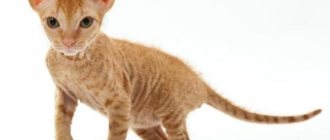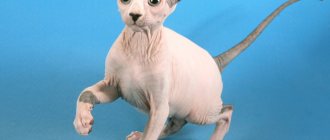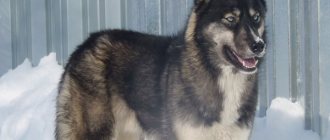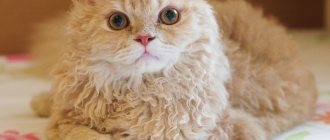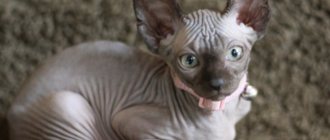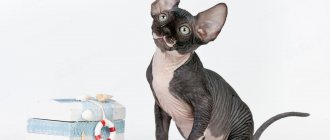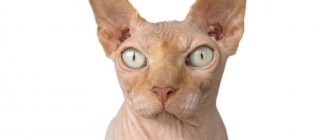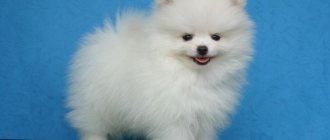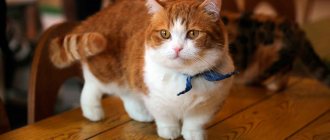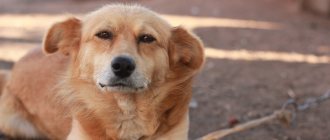Of all the Sphynxes, only the Brush variety arouses curiosity among cat lovers less than others. They traditionally prefer completely hairless animals with “rubbery” skin, and an even coat of short, plush hair immediately reduces the status of a representative of hairless cats, which in fact turns out to be quite overgrown. But there is no need to evaluate external signs so strictly - the Sphynx Brush is, in fact, a very interesting type of cat that deserves special attention from both breeders and potential owners.
Types of Sphynx coats
Brush animals were not bred on purpose - they appeared as a result of a gene mutation after crossing different types of cats. There are several types of Sphynx with fur, differing in the length and type of hair.
Flock
The body of pets is covered with a thin velvet pile, similar to the fluff on the surface of a peach. The fluff is very soft to the touch and almost invisible. The densest coat is found on the paws and tail. In the absence of developmental anomalies, by the age of 2 years all the hairs fall out on their own, and the animal’s skin is completely exposed.
Velours
The velor pet of the Sphynx breed has a bald head, and the hair length on the body reaches 2–5 mm - in appearance they resemble partially bald street cats. Most often, by adulthood, these animals also become bald, but sometimes the fur remains throughout their lives. Often the lint remains only on the paws and tail.
Brush
Pets of this breed differ in the density of their coat:
- Brush velor Sphynx kittens have hard hair that resembles stubble. On the sides and neck the fur is thinner, the skin is visible through it. With age, the fur can soften, and then the velor brushed Sphynx becomes more similar to representatives of the flock breed.
- After birth, the body of the Pointed Brush is covered with long and thick hair, and a barely visible bald patch stands out on the head. By 18–24 months, the length of the hair on the body remains about 1–2 mm, and on the tail, muzzle and paws the hair reaches 10 mm, becoming curly in some places.
- A kitten of the dense brush breed looks like an animal with straight fur - it does not have a bald spot on its head. Over time, the structure of the hairline changes - it becomes thick, and the skin is practically not visible through it. On the paws, chest and tail, the hair is longer and stiffer, and can be either straight or curly.
Note! Pets of this breed do not take part in exhibitions, but they are crossed with other types of sphinxes - this allows them to get strong offspring. This selection is due to the fact that when two representatives of hairless sphinxes are brought together, very weak or dead kittens are born.
Straight-haired
Straight-haired Sphynxes do not go bald over the years - they still have short hair that fits tightly to the skin, and pronounced, long whiskers. The breed appeared as a result of the mixing of Siamese or Oriental cats with Sphynx cats.
Breeding
One cat can give birth to up to 6 kittens
Velor cats take part in breeding. Basically, for these purposes, animals are brought in that fully comply with the breed standards, or are capable of producing high-quality offspring. Representatives of the pet class are not allowed to breed.
The first estrus in females begins at 6 months. But during this period they are not physically ready for conception and childbirth. Mating should be organized only after the cat’s third heat. The male matures for mating at the age of 1.5-2 years. Before mating, pets must be shown to a veterinarian. Animals must be vaccinated and healthy. Usually the tailed ones are left together in the cat's territory.
If the cat does not become pregnant, then the meeting with the sphinxes should be repeated in a few days. An unfertilized female will go into heat for about 14 days. If the female becomes pregnant, the estrus will stop. After 2-3 weeks, the owner may notice how the purr has gained weight and changed in character. At this time, your pet needs care and attention. She should eat three to five times a day. Food intake should be 30% more than usual. Childbirth occurs after 64 days. In total, a cat can give birth to 4 to 6 kittens.
Advantages and disadvantages of plush sphinxes
Adult Don Sphynxes reach 30 centimeters at the withers, males look larger, and their weight ranges from 6 to 7 kilograms, while females weigh no more than 5 kilos. With proper care, representatives of the Brush breed live 14–17 years.
Interesting! The Sphynx Brush's body temperature fluctuates between 38-39 degrees, so when you touch your pet's skin it feels hot.
Advantages of the little hairy dog of this breed:
- friendly attitude towards children, lack of aggression towards other people;
- high intelligence, ability to train;
- easy contact with other animals;
- cleanliness;
- long lifespan, provided proper maintenance;
- absence of fleas and hair around the house.
A hairy pet also has a number of disadvantages:
- the need for regular skin care;
- the importance of maintaining the correct microclimate in a living space;
- increased susceptibility to dermatological type pathologies;
- specific body odor;
- insatiable appetite, increasing the risk of obesity.
Possible diseases
Sphynx Brush cats have a genetic predisposition to the following pathologies:
- eczema;
- entropion of the eyelid or underdeveloped eyeball;
- dermatitis;
- conjunctivitis;
- shortened lower jaw.
Character
Velor beauties are very affectionate
Don Sphynxes are friendly cats. These are companions who are happy to spend time next to people: they love to lie on the couch with their owner, and run after a person around the apartment. Purrs, as sociable animals, find it sad to be alone for a long time. They are loyal, non-aggressive, but can be offended if the owner swears loudly.
The tailed cats of this breed are comfortable with living with dogs and other medium-sized pets. In addition, they get along with children: they are ready to play with kids and do not scratch. Animals are especially active when they are young. Adult cats prefer a quiet rest, but sometimes they are not averse to frolic.
Don Sphynxes are distinguished by their intelligence. They can be trained. But at the same time, you cannot roughly force the animal to obey, otherwise the pet will become stubborn. It is better to use the reward method - for each execution of a command you need to treat the cat with a treat. Hairless purrs can learn different tricks. Tailed animals are able to understand the requirements to “sit” and “lie down”. They love to fetch the ball.
Rules of care
These cats do not need serious care:
- Sphynx Brush cats are fed natural or premium dry food. Also, the cat’s body constantly needs a large amount of fluid and properly selected vitamins.
- Don't forget that the Sphynx Brush's ears and teeth need regular cleaning. Optimally - once a week.
- Brush cats need to be bathed regularly. You can buy a special product or take a good baby shampoo.
- Cats don't have eyelashes, so pay attention to their eyes. This is especially true for kittens - it is better to wipe their eyes with a damp, clean swab once a day.
Important! The hair of a plush Sphynx can change due to a new diet, temperature, humidity in the room, changes in hormonal levels during gestation or estrus.
Content Features
Many people get hairless cats in order to avoid endless combing and cleaning up fluff throughout the apartment. But, alas, sphinxes are far from the easiest breed to keep. If you want your pet to be in excellent shape and in a good mood, you will have to constantly spend a lot of money and time for this. And here’s a paradox: the less fur a cat has, the more expensive its beauty requires. In this sense, velor is the optimal coating option.
To wash or not to wash?
These amazing cats are special in everything - and in their care too. They are neat and very clean, but their own washing is still not enough; the owner must help the pet care for sensitive skin so that irritation and dermatological diseases that hairless animals are prone to do not occur. Mandatory hygiene for sphinxes has much in common, but there are also differences - depending on the type of coat.
All sphinxes are amazingly clean
All cats of this breed group “sweat”: their sebaceous glands secrete a special lubricant that cannot be distributed throughout the fur and remains on the skin. Without such natural nourishment, the skin will dry out and begin to peel. As soon as, while stroking your pet, you notice that your palm is dirty, it’s time to arrange a bath day.
Starting from the age of two months, “rubber” Sphynx cats are bathed weekly, using only special shampoos for hairless cats. Such frequent washing usually does not irritate the delicate skin and does not provoke allergies.
But you can also use other cleaning products, for example, special cat wipes. Velor cats can be bathed less often - once or twice a month as they become dirty - and you can also wipe off dust and dirt adhering to the skin with napkins - especially a lot of it collects in the groin and armpits. Too frequent bathing is not beneficial for any cat, including a hairless one. Remember also that cosmetics (creams, gels, lotions and conditioners) are suitable for sphinxes only with a certain acidity - with a pH of 3.8 to 4.5.
Hairless cats love to splash in warm water
The tail requires special care, the sebaceous glands on which are often clogged, inflamed, and covered with black dots - acne. To prevent this from happening, the tail should be washed with special products more often than the entire cat. The large eyes and huge ears of sphinxes also come into the area of increased attention - they must be kept clean so that there is no risk of infection. Like all cats, you need to monitor the condition of the teeth and claws of “baldy cats”.
Warm and satisfying
Warmth is the main condition for the happiness and health of any Sphynx. In the house where he lives, cold and drafts must be strictly prohibited. Warm beds, cozy clothes made of soft fabrics without seams - all this is included in the mandatory arsenal of the sphinx owner. If you do not provide the animal with a comfortable temperature, it will try to warm up near heating devices, where it can get skin burns. Also, exposure to direct sunlight often results in burns.
These cats always want to stay warm
Hairless cats that are always freezing are characterized by an accelerated metabolism and, as a result, an increased appetite. It is very important to correctly maintain a balance between the quantity and quality of food in the daily diet of such animals. Only practitioners with extensive experience can create a menu of natural products, so breeders usually recommend that those who get Sphynx dogs for the first time select ready-made food based on the tastes, health, and individual characteristics of their pet.
The following are considered the best ready-made food for sphinxes:
- Orijen Cat & Kitten (Canada) – holistic food;
- ACANA Grasslands for Cats (Canada) – holistic food;
- Purina Pro Plan Delicate (France) – super-premium;
- Royal Canin Sphynx Adult (USA, France) – premium class;
- Hill's Science Plan Adult Lamb (USA) – premium food.
The excellent condition of the skin and coat of your velor beauty is an unmistakable signal that the feeding regimen and menu have been chosen correctly. Pay special attention to the diet of sterilized animals.
A properly selected diet is very important for the Sphynx
As for breeding hairless cats, it is better to leave this complex topic to the professionals. Breeding work with all breeds of sphinxes is not only practice, but also a real science in which, alas, there are fewer discoveries than disappointments.
Finding a parent pair of sphinxes is not an easy task.
Price
Sphinx Brush is a case where price determines quality. The price cannot be low - focus on the price tag of $300. A high price will mean that the kitten has a pedigree. We also advise you to purchase babies only from trusted breeders, so the likelihood of buying a healthy kitten is much higher.
Brush Sphynxes are fragile creatures that require regular care and attention, so before purchasing a kitten, it is important to correctly calculate your strength to provide it with a decent life. Otherwise, there is a high risk of developing diseases that can significantly shorten the pet’s life.
Did you like the article?
Reviews
All owners of such tailed animals are very happy with them, it is impossible not to fall in love with them; as a rule, such pets become loved by all family members, even if someone is initially put off by their appearance. Cats of this variety are disciplined, easy to train and raise, and love to be photographed.
They are loyal and love their owners, meeting them at the doorstep and following them around the house everywhere. They often sleep in bed with people, love to purr on their knees and sleep in the warmth of human hugs.
To read: Features of caring for the Husky breed, advantages and disadvantages of the dog
Some take in adult animals, and they still quickly adapt to the new environment. They love children and easily find a common language with other representatives of the animal world. They do not spoil wallpaper and furniture, especially if you accustom them to scratching posts from childhood. They always go to the toilet in the litter box. The only thing that can be a problem for busy people is daily wiping, but for those who are already used to it, caring for a cat is a pleasure.
Cat Hair Types
Cat fur serves as an insulating layer between the skin and the external environment. The coat protects from cold and heat. Its type is classified depending on the thickness, length, and structure of the hair.
The type of cat's coat is an individual feature of each breed, regardless of color, and is determined by a specific combination of guard hairs, guard hairs and undercoat.
Undercoat
The undercoat consists of soft and fluffy hairs of equal diameter along the entire length, providing thermal insulation. It is the undercoat that helps animals keep warm during cold periods and protects them from overheating in hot weather. Without proper care, the undercoat becomes compacted, tangled, and tangles form. They are much larger in number, in contrast to the protective and guard layers, and they are the shortest, lying close to the body. When examining the undercoat under a microscope, it will appear corrugated (wavy), although at ordinary glance it appears straight.
Guard hair
The guard hair, or outer hair, forms the main middle layer of the coat. They are thinner than protective hair, stiff, with a thickening at the tip. The structure and length may vary depending on the breed. Some breeds have a awn that is the same length as the guard hair, while others have a shorter awn.
Protective hair
The guard hair usually determines the cat's base color. The protective top layer prevents the wool from getting wet quickly. Typically, guard hairs are longer than guard hairs, and are stiffer and coarser. They taper evenly to the tip along the entire length.
Pooh
Sparse, very fine hairs, characteristic of kittens. By the way, sphinxes’ hair is also called fluff. In adults, the down is difficult to distinguish.
Mustache
Vibrissae are long, thickened tactile hairs growing on both sides of the muzzle on the cheeks and above the eyes, as well as on the outer side of the lower leg. Vibrissae are very sensitive and important in a cat’s life. They cannot be cut, because with the help of whiskers the cat orients itself in space: it measures the distance to an object, finds its way in the dark, determines the direction of the wind, and recognizes odors. Whiskers are one of the ways cats communicate.
There are breeds with double or triple coats. Many people believe that some breeds do not have an undercoat, for example, the Turkish Angora, but in fact they do, it’s just weakly expressed, it is less abundant, unlike other breeds. Representatives of the Cornish Rex breed lack a awn, and wirehair cats have all three types of hair, they are all short and curly.
By the way, hair structure is determined genetically. Straight and curly hair in cats differ only in the shape of the shaft. Curly hair has a flat shaft, while straight hair has a round shaft.
Petersburg brush (Peterbald)
Russian breed, in the selection of which Don cats took part. Just like their predecessors, these sphinxes are covered with curly hair and some of them remain in this form for the rest of their lives. The second half “undresses” not completely. In adult cats, dense growth is observed on the face, tail and may be on the paws. This option is called brush point due to the characteristic location of the hair at the ends of the body.
How to choose a kitten
It is recommended to purchase a kitten only from trusted nurseries, since they may offer you not an exotic baby, but a sick animal. This is due to the difficulties of breeding the breed and the dishonesty of sellers.
You should not buy a kitten that is too young, as its body is still weak and can get an infection when moving, even under stress.
Reference! The optimal age for a baby to buy starts from 3 months. By this time, the baby is already strong and has the necessary vaccinations.
If your future pet is a personal companion and not a show winner, then it is enough to make sure that he is healthy. The kitten should be active, cheerful, and not show aggression or fear at the sight of a person. Sometimes kittens have a small rash on their tail - there is nothing wrong with that, it will go away on its own over time.
The final color of the kitten, as well as the color of the eyes, become clear to an experienced breeder already in the first weeks of the baby’s life.
It’s worth noting right away that sphinxes are not a cheap pleasure. If you are offered to buy a kitten for 3-4 thousand rubles, in this case there can be no talk of any pedigree.
The price of kittens in trusted nurseries starts from 10 thousand rubles.
Kittens that have deviations from breed standards are a little cheaper. They are not critical if you take a handsome bald man for your soul.
But promising kids - potential exhibitors and future producers, whose parents have championship titles, will cost at least 15 thousand rubles .
How to understand: will the kitten be fluffy?
Before getting any pet, everyone thinks about what size the animal will be when it grows up, or what its coat will be like - smooth, long, short, voluminous, and whether its color will change. Those who are planning to get a cat pay special attention to the fur of their future pet. It is very difficult for an ignorant person to determine at first glance whether a kitten will be fluffy, which is why today we will tell you in detail how to determine whether a kitten will be fluffy when it grows up.
